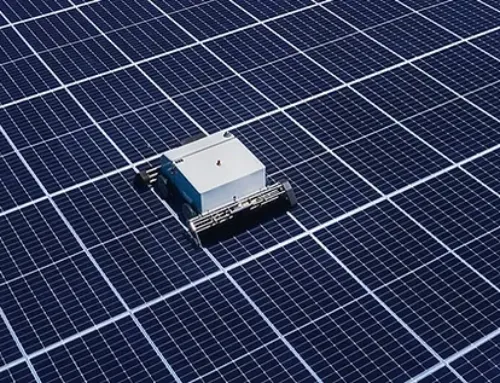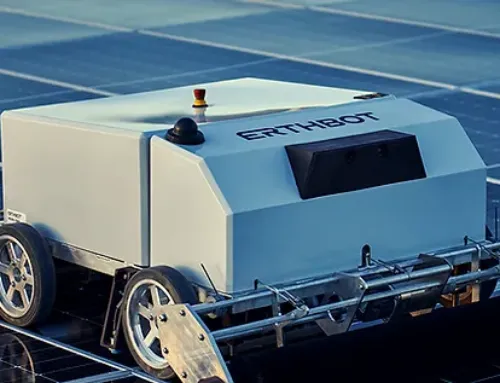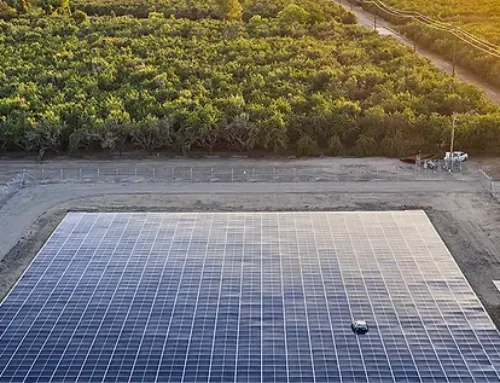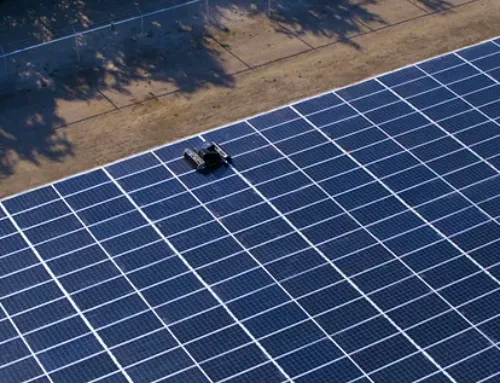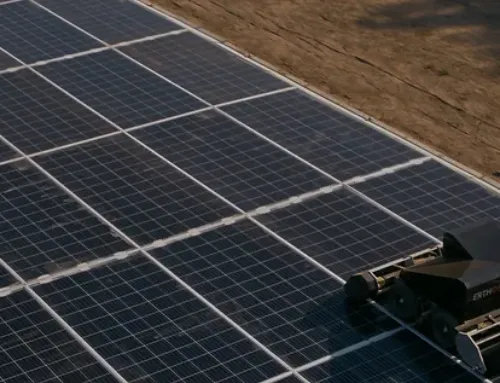What happens if you install solar panels directly on the ground and then subject them to a wild and wet California winter replete with 12 atmospheric rivers, two bomb cyclones and 80-mile-per-hour wind gusts? I visited a Central California solar farm built by the startup Erthos to find out.
Since the company unstealthed in June 2021, Erthos has deployed 3 megawatts of large-scale solar generation using a unique system that places photovoltaic panels on the ground instead of using elevated steel racking or trackers.
The system is a fundamental overhaul of how utility-scale solar is constructed. And as Canary Media reported when Erthos raised $17.5 million in March 2022, the company claims this system has the potential to take a bite out of the rising costs of solar installations by cutting out “unnecessary materials and risks,” speeding up construction time and reducing land use.
While solar is the cheapest source of new energy generation, the price of installations is no longer falling. From 2010 to 2021, the levelized cost of installing utility-scale solar fell 88 percent thanks to economies of scale, better technology and supply-chain improvements, according to the International Renewable Energy Agency. But supply-chain issues have reversed this trend globally, and tariffs have added costs in the U.S. Meanwhile, increasingly expensive commodities such as steel, aluminum and glass now account for more of the cost of a solar panel. As a result, large-scale solar pricing is now rising in the U.S.
In the midst of these cost headwinds, Erthos is promising a cost reduction of 20 percent, a significant savings for a mature industrial commodity like solar.
But Erthos’ approach has prompted a lot of questions from skeptics and curious observers alike — about moisture, soiling, maintenance and performance. Here’s what I saw on my visit to one of its Chowchilla installations.
Pumping water with solar power
The 617-kilowatt (DC) solar array I visited, one of several of the company’s modest California-based deployments, is nestled among almond groves in the Central Valley of California, a vast, verdant plain that produces a remarkable 25 percent of the nation’s food.
Growing all that food means pumping water for irrigation, and pumping that much water requires a lot of electricity. This particular Erthos solar array supplies energy to a number of farmers to run their well pumps in an aggregated meter arrangement, according to Daniel Flanigan, chief marketing officer at Erthos.
Despite this winter’s historically foul weather and the technology’s relative infancy, “the power plant performed within 1 percent of predicted energy [generation], so it’s working as intended.” The earth acts as a heat sink, and since solar panel performance degrades in heat, thermal performance of the array has proven to be better than predicted. “And the civil design has enabled proper drainage,” said Flanigan.
None of the site’s 1,386 panels were lost to wind this winter, Flanigan said, noting that its panel installation scheme has achieved a 194-mile-per-hour wind rating, good enough to withstand a Category 5 hurricane.
In addition, the panels sustained minor levels of soiling loss over the winter due to the cleaning robot that leaves its shed nightly to tidy up the place. The robot is equipped with a GPS system that allows precise orientation to determine exactly where the unit is on the array within a few inches. Flanigan said the cleaning robot could soon get additional capabilities, such as infrared sensors that detect defects and allow for quicker replacement of modules.
When a module does need replacement, it’s a straightforward process, according to a demonstration the company conducted for your humble narrator. After the biblical wind and rain of this winter, a two-worker crew lifted up a module on the interior of the array to reveal…dirt. Maybe a little wetter than the surrounding dirt, but there were none of the underground rivers, snapping turtles or scorpions of unusual size that I had envisioned.
The company uses a proprietary hole pattern to allow electrical connections to reach its modules, as well as a unique system of threading the cables to provide a supportive mesh that conforms to the contours of the land. The system uses standard solar inverters to convert the electricity generated at the site into grid-ready power.
Connectors are a potential weakness in any electrical system — especially in a wet environment. Erthos is using connectors that are rated to withstand a certain level of full submersion, but it’s also working with vendors to develop extended submersion ratings for connectors, components and entire modules.
“We want to push the limits,” said Chad Medcroft, VP of products at Erthos.
The company also contends that its design can be installed on varied topographies with little need to grade and none of the subterranean soil surprises that can be encountered when drilling foundations for solar racking.
Erthos maintains that all of the aforementioned helps it deliver a 20 percent cost savings on capital expenditures, a 24 percent reduction in levelized cost of energy and a 29 percent savings in operations and maintenance costs. These are deeply compelling cost reductions for a mature commodity market.
Delivering on its main pitch — cutting racking costs — would be a huge win on its own. In the U.S., solar racking currently accounts for about $0.15 per watt for a 100-megawatt system, according to a report from the Solar Energy Industries Association and Wood Mackenzie Power & Renewables, out of a total system cost of about $1.32 per watt, according to the U.S. Energy Information Administration.
But Erthos still has to prove that its estimated cost savings hold true at scale. It will have its first major opportunity to do so soon, with the forthcoming 100-megawatt utility-scale solar project announced in December by Erthos and project developer Industrial Sun.
Visiting the startup’s Chowchilla site didn’t necessarily convince me that its unheard-of approach is bulletproof, but it did demonstrate that the company’s facilities share one important trait with the scores of other installations I’ve visited over more than a decade of reporting: It’s kind of boring.
Despite the cutting-edge technology and human effort to get them built, solar farms are inspiring in their simplicity. Photovoltaic solar installations have few moving parts except for maybe electrons — ideally, they sit there doing little but sending power to the grid when the sun is out. The best thing I can say about Erthos’ solar farm is that it’s boring, too.
About Erthos
Founded in 2019 and located in Tempe, Arizona, Erthos offers a full suite of products and services aimed at helping developers dramatically reduce the levelized cost of energy or “LCOE” on utility-scale solar power plants. Its executives and management hail from companies including Tesla, Intel, General Electric, SunPower Corporation, First Solar, Depcom Power, Sterling & Wilson, SMA, Solar Frontier, and Plug Power. The team has extensive experience with new product introductions and global markets, including the US, Latin America, Australia, Europe, the Middle East, Africa, India, Asia, and the Pacific. Find out more about Erthos at www.erthos.com.
